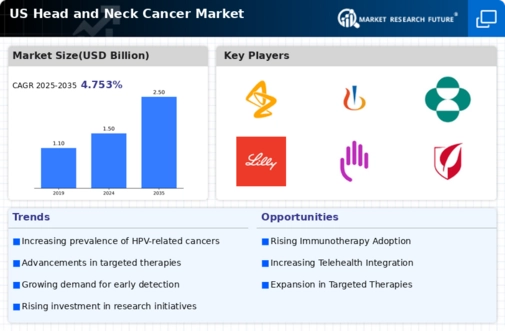Rising Incidence Rates
The head and neck cancer market is experiencing a notable increase in incidence rates, particularly among certain demographics. Data indicates that the incidence of oropharyngeal cancers, often linked to HPV, has risen significantly in the past decade. This trend is expected to continue, with projections suggesting that by 2026, the number of new cases could exceed 54,540 annually in the US. This rising incidence is likely to drive demand for innovative treatment options and diagnostic tools, thereby expanding the head and-neck-cancer market. As healthcare providers adapt to these changing dynamics, the market is poised for growth, with an emphasis on personalized medicine and advanced therapeutic strategies.
Increased Awareness and Education
There is a growing emphasis on awareness and education regarding head and-neck cancers, which is influencing the market positively. Public health campaigns and initiatives aimed at educating the population about risk factors, symptoms, and the importance of early detection are becoming more prevalent. This heightened awareness is likely to lead to earlier diagnoses, which can improve treatment outcomes. As a result, the head and-neck-cancer market may see an increase in patient referrals and consultations, ultimately driving demand for diagnostic and therapeutic services. By 2025, it is projected that awareness campaigns could lead to a 20% increase in early-stage diagnoses.
Advancements in Surgical Techniques
Recent advancements in surgical techniques are transforming the landscape of the head and-neck-cancer market. Minimally invasive procedures, such as transoral robotic surgery (TORS), have gained traction, offering patients reduced recovery times and improved outcomes. These innovations not only enhance surgical precision but also minimize complications, which is crucial for head and-neck cancer patients. The adoption of these techniques is expected to increase, with estimates suggesting that by 2025, minimally invasive surgeries could account for over 30% of all head and-neck cancer procedures. This shift is likely to stimulate market growth as healthcare providers seek to implement the latest surgical technologies.
Regulatory Support for Innovative Therapies
Regulatory bodies are increasingly supportive of innovative therapies in the head and-neck-cancer market, facilitating faster approvals for new treatments. The FDA has implemented programs such as Breakthrough Therapy Designation, which expedites the development and review of drugs that show promise in treating serious conditions. This regulatory environment is conducive to the introduction of cutting-edge therapies, including combination treatments and personalized medicine approaches. As a result, the head and-neck-cancer market is likely to benefit from a surge in new product launches, enhancing treatment options available to patients and potentially improving survival rates.
Growing Investment in Research and Development
Investment in research and development (R&D) within the head and-neck-cancer market is on the rise, driven by the need for more effective therapies and treatment modalities. Pharmaceutical companies and research institutions are increasingly focusing on developing novel agents, including immunotherapies and targeted therapies. In 2025, it is anticipated that R&D expenditures in oncology will surpass $50 billion in the US, with a significant portion allocated to head and-neck cancers. This influx of funding is expected to accelerate the pace of innovation, leading to the introduction of new treatment options that could reshape the head and-neck-cancer market.

















Leave a Comment